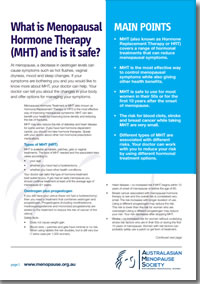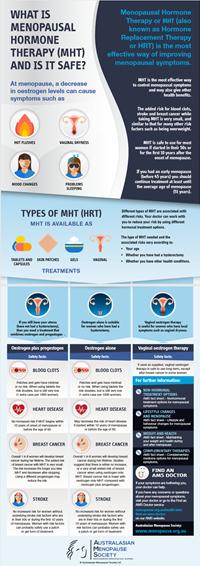What is Menopausal Hormone Therapy (MHT) and is it safe?

MAIN POINTS
- MHT (also known as Hormone Replacement Therapy or HRT) covers a range of hormonal treatments that can reduce menopausal symptoms.
- MHT is the most effective way to control menopausal symptoms while also giving other health benefits.
- MHT is safe to use for most women in their 50s or for the first 10 years after the onset of menopause.
- The added risk for blood clots, stroke and breast cancer while taking MHT is very small, and similar to that for many other risk factors such as being overweight.
- Different types of MHT are associated with different risks. Your doctor can work with you to reduce your risk by using different hormonal treatment options.
Download Fact Sheet ![]() What is Menopausal Hormone Therapy (MHT) and is it safe?93.67 KB
What is Menopausal Hormone Therapy (MHT) and is it safe?93.67 KB
 Download Infographic
Download Infographic ![]() What is Menopausal Hormone Therapy (MHT) and is it safe?908.66 KB
What is Menopausal Hormone Therapy (MHT) and is it safe?908.66 KB
At menopause, a decrease in oestrogen levels can cause symptoms such as hot flushes, vaginal dryness, mood and sleep changes. If your symptoms are bothering you and you would like to know more about MHT, your doctor can help. Your doctor can tell you about the changes in your body and offer options for managing your symptoms.
Menopausal Hormone Treatment or MHT (also known as Hormone Replacement Therapy or HRT) is the most effective way of improving menopausal symptoms. MHT can also benefit your health by improving bone density and reducing the risk of fractures. MHT may also reduce the risk of a fracture and heart disease for some women. If you have had hormone-dependent cancer, you should not take hormone therapies. Speak with your doctor about other non-hormonal prescription medications.
Types of MHT (HRT)
MHT is available as tablets, patches, gels or vaginal treatments. The type of MHT needed and the associated risks varies according to:
- your age
- whether you have had a hysterectomy
- whether you have other health conditions.
Your doctor can tailor the type of hormone treatment best suited to you. If you had an early menopause you should continue treatment at least until the average age of menopause (51 years).
Oestrogen plus progestogen
If you still have your uterus (have not had a hysterectomy), then you need a treatment that combines oestrogen and progestogen. Progestogens (including norethisterone, medroxyprogester , one dydrogesterone and micronized progesterone) are added to the treatment to reduce the risk of cancer of the uterus. Safety facts:
- Does not cause weight gain
- Blood clots – patches and gels have minimal or no risk. When using tablets the risk doubles, but is still very low (1 extra case per 1,000 women).
- Heart disease – no increased risk if MHT begins within 10 years of onset of menopause or before the age of 60.
- Breast cancer - overall 1 in 8 women will develop breast cancer during her lifetime. The added risk of breast cancer with MHT is very small. The risk increases the longer you take MHT and decreases after stopping. Using a different progestogen may reduce the risk.
- Stroke – no increased risk for women without underlying stroke risk factors who are in their 50s or during the first 10 years of menopause. Women with risk factors can probably safely use a patch or gel form of treatment.
Oestrogen alone
Oestrogen alone is suitable for women who have had a hysterectomy.
Safety facts:
- Blood clots – patches and gels have minimal or no risk. When using tablets the risk doubles, but is still very low (1 extra case per 1000 women).
- Heart disease – may decrease the risk of heart disease if started within 10 years of menopause or before the age of 60.
- Breast cancer - overall 1 in 8 women will develop breast cancer during her lifetime. Studies suggest that there is either no increase, or a very small added risk of breast cancer when using oestrogen only MHT. Breast cancer risk is lower with oestrogen only MHT compared with oestrogen plus progestogen.
- Stroke – no increased risk for women without underlying stroke risk factors who are in their 50s or during the first 10 years of menopause. Women with risk factors can probably safely use a patch or gel form of treatment.
Vaginal oestrogen therapy
Vaginal oestrogen therapy is useful for women who have local symptoms such as vaginal dryness. Safety fact:
If used as supplied, vaginal oestrogen therapy is safe to use long-term, except after breast cancer.
Tibolone
Tibolone is taken as a single tablet and has some oestrogen, progesterone and testosterone effects. Many, but not all, women find tibolone helps with symptoms and may also improve sexual function. Tibolone is also suitable to reduce the risk of osteoporosis (thinning of the bones) in post-menopausal women.
Safety facts:
- Blood clots – no increase in risk.
- Heart disease – no increase in risk.
- Breast cancer – reduces breast density/tenderness and no increase in breast cancer risk with three years of use.
- Stroke – increase in risk if started after the age of 60.
Oestrogen combined with a SERM
SERMS (selective oestrogen receptor modulators) are a newer treatment option for menopause. They have anti-oestrogen or oestrogen-like effects that vary in different parts of the body.
A tablet containing conjugate equine oestrogen combined with the SERM bazedoxifene improves menopausal symptoms, bone density and reduces breast density. Bazedoxifene, like progestogen, reduces the risk of cancer of the lining of the uterus in women who have not had a hysterectomy.
Safety fact:
- SERMs can be combined with oestrogen to improve symptoms, improve bone density and reduce the risk of uterine cancer.
Where can you find information about other treatment options?
If your symptoms are bothering you, your doctor can help. Your doctor can tell you about the changes in your body and offer options for managing your symptoms. Other fact sheets about treatment options include:
- Non-hormonal treatment options (See AMS fact sheet – Non-hormonal treatment options for menopausal symptoms)
- Lifestyle changes and menopause (See AMS fact sheet – Lifestyle and behaviour changes to manage menopausal symptoms)
- Complementary therapies (See AMS fact sheet – Complementary medicine options for menopausal symptoms)
Information for your doctor to read includes AMS Information Sheets:
- Risks and benefits of MHT
- AMS Guide to equivalent MHT/HRT doses Australia only or AMS Guide to equivalent MHT/HRT doses New Zealand only
- Combined MHT
- Oestrogen only MHT
- Tibolone for post-menopausal women
If you have any concerns or questions about options to manage your menopausal symptoms, visit your doctor or go to the Find an AMS Doctor service on the AMS website.

NOTE: Medical and scientific information provided and endorsed by the Australasian Menopause Society might not be relevant to an individual’s personal circumstances and should always be discussed with their own healthcare provider. This Information Sheet may contain copyright or otherwise protected material. Reproduction of this Information Sheet by Australasian Menopause Society Members, other health professionals and their patients for clinical practice is permissible. Any other use of this information (hardcopy and electronic versions) must be agreed to and approved by the Australasian Menopause Society.
Content updated December 2019
